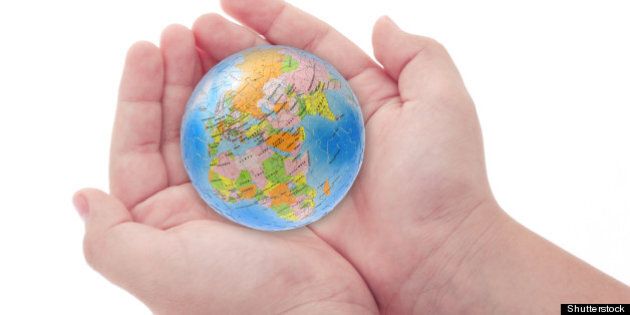
Nothing imprints things upon our brains like seeing them with our own two eyes. That's why most of us are not content with simply seeing pictures of pyramids, the Great Wall of China and the Grand Canyon; we'd much rather go visit them.
In today's world, humans are consuming more than ever, but many consequences of the way we live are far from the average person's eyes and thoughts. So here are six places we'd all do well to visit, for a reality check, some imprinting and some reflection.
A mine site
Mines are the source of many of the materials we depend on daily. It's easy to assume that they are merely holes in the ground that yield gold, silver and other valuables, but reality is not quite that simple. In most cases, what we want is present at trace levels only, mixed in with a lot of what we don't want. That means much ore must be mined and moved. It means what we want must be extracted from the ore, a process that involves a lot of energy and/or the use of toxic chemicals with long-lasting health and environmental impacts. It results in tailings: heaps or ponds of waste materials that can languish and leach for a very long time (particularly in places where regulations are weak).
But perhaps more than anything else, mines are real-life reminders of what "non-renewable" means, because they eventually get depleted. Brunswick Mines in Bathurst, New Brunswick was the world's biggest lead/zinc deposit when it opened in 1964, but it's all gone now; the mine is closing forever this month. A graphic reminder to reduce, reuse and recycle.
A meat processing plant
Most of us are comfortably insulated from the supply chain that delivers food to our plate, and that's especially true of meat. For those able to bear it, a visit to a processing plant promises to be very imprinting.
An emotional response might have us outraged and pointing fingers. A rational response might have us understanding that what happens daily on the processing floor is just a logical consequence of a hungry, carnivorous society that demands ever cheaper food.
A balanced response might have us wondering about our own dietary choices and how we can best get the nutrition we need. It's no secret that plant-based foods have a much lower carbon footprint than animal-based foods, and that North American meat consumption is among the highest in the world.
A landfill
In our world, trash disposal couldn't be much easier: we just put our unwanted stuff at the curb and it magically disappears. No fuss, no mess -- and no responsibility or incentive to generate less garbage.
So perhaps a tour of our local landfill would help us understand that nothing disappears; it just goes elsewhere. That taking care of society's waste is a complicated, unsavoury and expensive business. That, in spite of our best efforts, landfills are not pretty places and they continue to seep and belch their contents long after we've filled them and moved on.
Perhaps it would help us understand that producing less trash is a smart thing to do.
A clear cut, before and after
Several years ago, a parcel of mature forest near my home was clearcut. In just weeks, it went from being a vibrant, undisturbed habitat for birds, amphibians, wildlife and people to a deserted, visually jarring moonscape with only ruts, mud, stumps and slash heaps.
Trees are a cornerstone of our planet's terrestrial ecosystems, but in our economic system, they only have value when they're cut. A visit to a forest before and after clearcutting reminds of the need for conservation and management of our precious resources, and for sharing our space with other creatures that have no less right to be here than we do.
The Great Pacific Garbage Patch
This must-see isn't very realistic for a visit, but picture a giant ocean whirlpool constantly drawing in more and more plastic and you get the idea.
The Pacific trash vortex is believed to contain over three million tonnes of plastic, most of which originated on land but entered the ocean thanks to wind and rivers. You wouldn't see much of it if you visited, however: most of it consists of tiny particles, the remnants of bottles, bags and other debris.
And therein lies the problem. In ocean environments, plastics are forever: they break down into small particles but never really go away. They accumulate toxins and enter food chains.
The plastics are so widely dispersed that cleanup is virtually impossible. Recent research suggests there are similar garbage patches in the Indian and Atlantic Oceans.
Even without an actual visit, a few conclusions become clear. Plastics don't belong in the ocean. Recycling is good; reducing is even better. Litter sucks and beach cleanups rock.
The Tar Sands
It's easy to breeze through a gas station without a thought about the origins and journey of those litres of fuel. But our world's insatiable thirst for oil means that all the easy stuff is gone and we are forced to resort to dirtier, riskier sources like tar sands. Even if the oil burned here in Eastern Canada doesn't come from Alberta (at least for now), our consumption adds to the collective demand driving the resource feeding frenzy in Fort McMoney.
The extraction of oil from tar sands is an engineering wonder and an economic drug, but it's hard to disagree that it's also an act of gross environmental carnage. Conventional extraction involves total disruption of the landscape, huge amounts of water and massive tailings ponds laden with noxious byproducts. Plus greenhouse gas emissions.
By the industry's own measures, the current active mining footprint is 760 km² -- the combined areas of the cities of Saint John, Moncton, Fredericton and Miramichi. It's an enormous scar being scratched bigger daily, with the potential to increase sixfold. Tailings ponds are nearly the size of the cities of Bathurst and Edmundston combined. Just 10 per cent of the land mined since the 1960s has been or is being reclaimed by industry. A new study by Environment Canada and Queens University conclusively links tar sands development to increased toxin levels in nearby lakes.
For a bit of eye poison and to underscore the need for breaking our addiction to oil, there's probably no better destination on the planet than the tar sands.
Perhaps visits to these six sites -- a mine, a meat processing plant, a landfill, a clearcut, an ocean garbage patch and tar sands -- could somehow have a similar effect for us, imprinting the need for us all to live more sustainably -- on Earth Day and every day.
Carl Duivenvoorden (www.changeyourcorner.com; @CDuivenv) is a speaker, writer and green consultant
living in Upper Kingsclear, New Brunswick.
